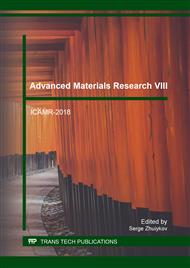p.193
p.199
p.204
p.209
p.216
p.222
p.227
p.232
p.237
Numerical Simulation of Collision Effect on Damage Evolution in Electromagnetic Forming of Aluminum Alloy Sheet
Abstract:
A numerical simulation study of collision effect on damage evolution in electromagnetic forming (EMF) was presented. EMF technology can greatly improve the forming limit of metal sheet duo to the high rate. However, collision behavior is also an important factor for the formability of sheet. Free form model and conical die model were carried out to study the effect of collision behavior on mechanical properties of Al alloy sheet. The EMF process of 1050 Al alloy sheet was analyzed and discussed by numerical analysis software LS-DYNA. The combined strategy of boundary element method and finite element method was adopted to realize the coupling calculation of electromagnetic field and structural field. Based on the GTN material model, the evolution of void volume fraction of 1050 Al sheet were calculated and analyzed. Comparing the free form model results and the die form model results, showed that the collision behavior could reduce the void volume fraction of sheet, but excessively high collision speed lead to the sheet rebound, which aggravated the damage of material and reduce the accuracy of the product. Therefore, the appropriate discharge voltage in this work was found to improve mechanical property of sheet on the premise of forming precision.
Info:
Periodical:
Pages:
216-221
Citation:
Online since:
March 2018
Authors:
Price:
Сopyright:
© 2018 Trans Tech Publications Ltd. All Rights Reserved
Share:
Citation:


